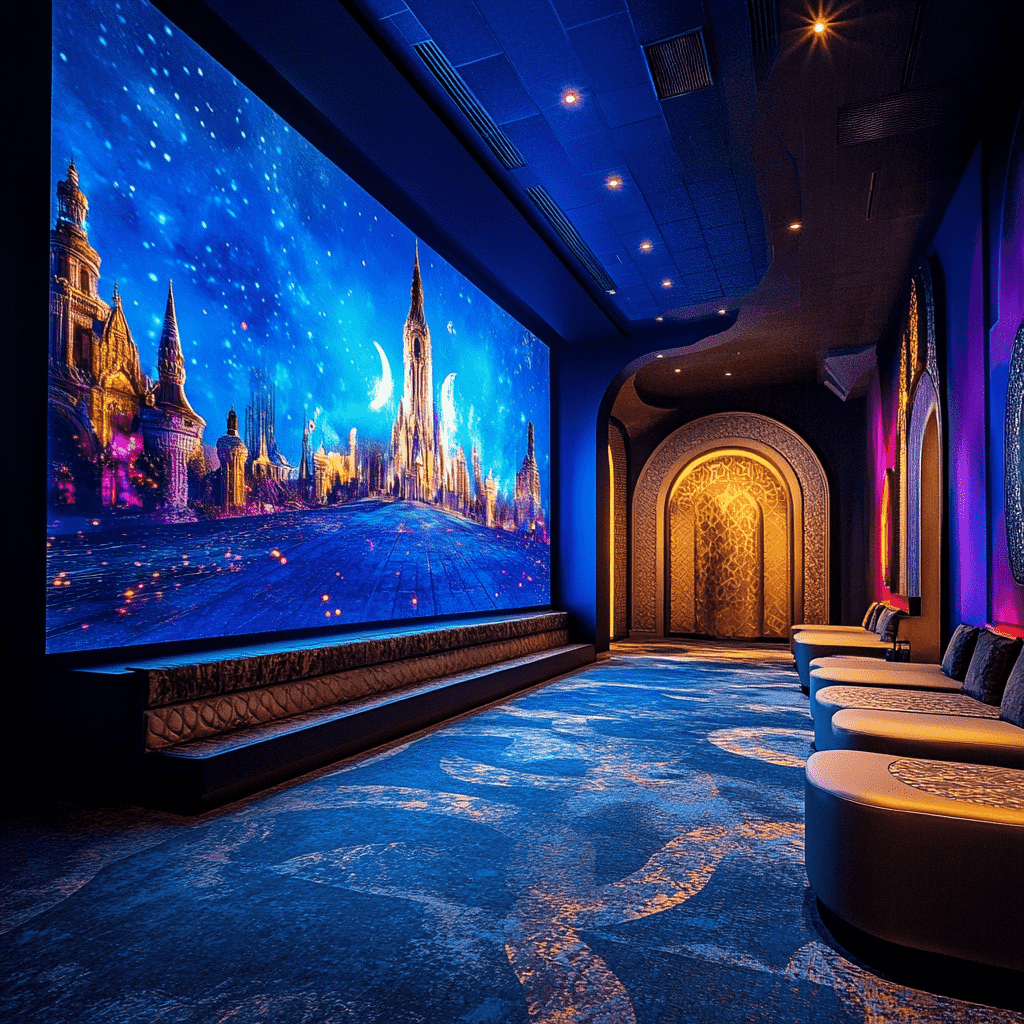
What's After the Blog?
History • Trailers
The History and Evolution of Film Trailers
Discover the fascinating journey of film trailers from their early beginnings to modern digital masterpieces in our in-depth exploration of their evolution and impact on cinema.
November 11, 2024

Movies mentioned in this article
The History and Evolution of Film Trailers
Introduction
Film trailers have become an integral part of the cinematic experience, offering audiences tantalizing previews of upcoming movies and setting the tone for what’s to come. These brief, often exhilarating snapshots are not just about promoting a film; they’re an art form in themselves, crafted to captivate, intrigue, and sometimes even mislead the audience. The evolution of film trailers from simple movie announcements to sophisticated marketing tools reflects the changing landscape of the film industry and audience expectations. Today, platforms like ATM enhance this experience by providing additional information like end credit scenes, making the post-trailer anticipation even more exciting.
The Origin of Film Trailers
The concept of film trailers dates back to the early 20th century, around the 1910s. Contrary to what one might expect, these early trailers were not shown before the main feature – the term “trailer” comes from them originally being shown at the end of a film. These early versions were quite different from what we know today. Rather than being produced by studios, they were often created by the theaters themselves as a way to advertise upcoming attractions. The First Trailers:
- Loews Cinemas were among the pioneers, creating short promotional films for their theaters.
- These early trailers were straightforward, often just featuring a series of slides or a short piece of film showcasing scenes from the upcoming movie.
As the film industry grew in the 1920s and 1930s, so did the sophistication of trailers. Studios began to take over trailer production, recognizing their potential as powerful marketing tools. The change was significant:
- Trailers evolved from simple announcements to more elaborate mini-movies, complete with their own narratives and hooks.
- Musicals of the era, like “The Wizard of Oz” (1939), used trailers to showcase their lavish production numbers, giving audiences a taste of the spectacle.
- Horror movies, such as “Frankenstein” (1931), used trailers to build suspense and intrigue, often without revealing the monster to keep audiences guessing.
The 1940s and 1950s saw further evolution in the style and content of trailers. This was the era of the “Golden Age of Hollywood,” and trailers became even more dramatic and enticing:
- The trailer for “Casablanca” (1942) emphasized the film’s romantic and exotic aspects, appealing to a wide range of viewers.
- “Gone with the Wind” (1939) had a trailer that mirrored the epic scale of the movie itself, with grand visuals and dramatic music.
These early decades laid the foundation for the trailers we see today. They established the trailer as an essential part of the movie-going experience, setting the stage for the creativity and innovation that would follow in the coming years.
Evolution in the Golden Age of Hollywood
The Golden Age of Hollywood, spanning from the 1930s to the 1950s, marked a significant era in the evolution of film trailers. This period saw the emergence of trailers as a crucial marketing tool for studios, aiming to entice a burgeoning movie-going audience. Trailers began to adopt a more formulaic and sensational approach, often narrated by voice-over artists who would later become a staple in trailer production. The trailers of this era were characterized by their dramatic flair, often using bold text and sensational taglines to capture the audience’s attention. Key Developments:
- Narration: The use of a strong, commanding voice-over became popular during this era. This narrative style set the tone and often included persuasive language to entice viewers.
- Dramatic Music: Trailers started utilizing music more strategically, with orchestral scores that heightened the emotional impact of the visuals.
- Star Power: The focus on movie stars became more pronounced. Trailers for films like “Gone with the Wind” prominently featured the actors, understanding that the star appeal was a major draw for audiences.
- Genre-Specific Styles: Different genres began to adopt specific styles for their trailers. For example, film noirs like “Double Indemnity” used suspenseful music and shadowy visuals, while musicals showcased their elaborate dance numbers.
This period also saw the rise of trailer-specific production companies, indicating the growing importance of trailers in a film’s success. Trailers were no longer just an afterthought; they became an integral part of a film’s marketing campaign.
Technological Advancements and Trailer Innovations
The 1960s and 70s were pivotal decades for film trailers, thanks to significant technological advancements in both film production and distribution. The introduction of color film and improved sound technology led to more visually and auditorily striking trailers. This era also witnessed the rise of television as a mainstream medium, providing a new platform for trailers and drastically increasing their audience reach. Impact of TV and the Internet:
- Television: With the advent of TV, trailers reached audiences in their homes, making them a part of everyday life. This increased exposure changed the way trailers were produced, with a focus on shorter, more concise formats to suit TV programming.
- Creative Techniques: Filmmakers began experimenting with more creative techniques in trailers, using rapid editing, unique visual effects, and non-linear storytelling. This was seen in trailers for movies like “2001: A Space Odyssey” which used mysterious and abstract imagery to intrigue viewers.
- The Internet Era: The rise of the internet in the late 90s and early 2000s transformed trailers once again. Platforms like YouTube allowed for immediate and widespread distribution of trailers, reaching a global audience instantly. It also enabled viewers to watch trailers on-demand, a significant shift from the scheduled programming of television.
“How did the introduction of TV and the internet change film trailers?” The advent of these technologies made trailers more accessible, allowing for greater creativity in their production and more strategic timing in their release. The internet, in particular, changed the game by enabling viral marketing campaigns and instant audience feedback, factors that are now crucial in the planning and execution of film trailers.
The Modern Trailer: A Marketing Powerhouse
In the modern era, starting from the 1980s to the present day, film trailers have evolved into a marketing powerhouse, essential for a movie’s commercial success. This period is marked by the increasing sophistication of trailer production, utilizing high-quality special effects, carefully chosen soundtracks, and strategic storytelling techniques. Trailers are no longer just previews but carefully crafted pieces of art designed to generate hype and anticipation. Strategies and Innovations:
- Teaser Trailers: The concept of teaser trailers emerged, offering a brief glimpse of a film, often months in advance of its actual release. These teasers, like the one for “Star Wars: The Force Awakens,” create an initial buzz, setting the stage for the full trailers to follow.
- Full Trailers: Full trailers provide a more comprehensive look at the film, often including a mix of dramatic scenes, action sequences, and a hint of the plot. They are designed to tell a story within themselves, as seen in trailers for movies like “Inception.”
- Timing and Release Strategy: The timing of trailer releases has become a strategic decision, often aligned with significant events or dates, like the Super Bowl or major film festivals, to maximize exposure.
Modern trailers also utilize a variety of digital platforms for distribution, including social media, which allows for immediate and widespread sharing. This digital evolution has transformed the way audiences interact with trailers, making them a key component in the film’s promotional campaign.
The Art of Crafting a Trailer
Creating an effective trailer is a complex art form that involves several key elements. The goal is to strike the perfect balance between revealing enough to attract audiences and withholding enough to maintain the movie’s intrigue and mystery. Key Elements of Trailer Production:
- Scene Selection: Choosing the right scenes is crucial. The selected scenes must be visually striking and emotionally engaging without giving away too much of the plot.
- Music and Sound: The soundtrack of a trailer plays a vital role in setting the tone. Whether it’s an original score or a well-chosen song, the music needs to complement the visuals and enhance the overall mood.
- Voice-Over and Text: While less common than in the past, voice-overs and on-screen text can provide necessary context or add to the trailer’s dramatic effect.
- Pacing and Rhythm: The editing of a trailer must create a rhythm that builds excitement. This involves careful pacing, ensuring a balance between slower, more dramatic moments and faster, action-packed sequences.
The creation of a trailer is a collaborative process, often involving the director, editors, marketing teams, and sometimes even the actors themselves. The end result is a mini-masterpiece, a distillation of the film’s essence designed to captivate and intrigue the audience. In the age of digital media, where trailers are easily accessible on platforms like ATM, the art of trailer making has become more important than ever in drawing audiences to theaters or streaming services.
Trailers in the Digital Age
The advent of the digital age has revolutionized the way film trailers are distributed and consumed. Platforms like YouTube and social media channels have become primary outlets for trailer releases, allowing for instant global reach and audience engagement. This shift has also led to a change in trailer production strategies, with an emphasis on creating content that is not only captivating on the big screen but also compelling on smaller digital screens. Impact of Digital Platforms:
- Wider Reach: Digital platforms have enabled trailers to reach a global audience instantaneously. A trailer released online can be viewed, shared, and discussed by millions within hours of its release.
- Social Media Influence: Social media platforms have become a battleground for creating viral marketing campaigns. Trailers are now designed with shareability in mind, often including memorable moments or catchy taglines that resonate with the online audience.
- Viewer Analytics: Digital platforms provide studios with valuable data on viewer engagement and preferences, influencing how trailers are tailored for different demographics and interests.
“How have platforms like YouTube and social media changed the way audiences interact with film trailers?” The interaction has become more immediate and personal. Viewers can like, comment, and share their reactions, creating a direct line of feedback to the filmmakers and studios. This interaction has also led to the creation of fan-made trailers and parodies, further extending the life and reach of the original trailers.
The Future of Trailers
As we look towards the future, it’s clear that the evolution of film trailers is far from over. Emerging technologies like virtual reality (VR) and augmented reality (AR) are set to offer even more immersive and interactive trailer experiences. The potential for interactive trailers, where viewers can choose different paths or perspectives, could revolutionize the way trailers are experienced and engaged with. Emerging Trends and Technologies:
- Virtual Reality and Augmented Reality: VR and AR could allow viewers to step into the world of the movie, offering a more immersive preview experience. Imagine exploring the world of “Avatar” through a VR trailer.
- Personalization: Advances in AI and data analytics might lead to personalized trailers, tailored to individual viewer preferences and viewing history.
- Interactive Elements: The integration of interactive elements in trailers, allowing viewers to engage with the content in a more active way, could become more prevalent.
As these technologies develop, the challenge for filmmakers and marketers will be to balance innovation with the core purpose of a trailer – to pique interest and entice viewers to watch the movie. The future of trailers is bound to be exciting, offering new ways for audiences to connect with and experience upcoming films. One thing is certain: trailers will continue to evolve, mirroring changes in technology, viewer habits, and the film industry itself.
Conclusion
As we have journeyed through the history and evolution of film trailers, it becomes evident that they are much more than just a promotional tool for movies. They have evolved into a unique form of storytelling, capturing the essence of a film in a matter of minutes and leaving a lasting impression on the audience. From their humble beginnings in the early 20th century to the high-tech, multi-platform spectacles of today, trailers have continuously adapted to changing technologies and audience preferences. They not only reflect the filmmaking trends of their times but also influence how audiences perceive and engage with cinema. As the film industry continues to evolve, so too will the art of the trailer, promising even more innovative and captivating previews in the years to come.
Invitation to Explore More
This exploration of the history and evolution of film trailers is just a glimpse into the fascinating world of cinema. We invite you to dive deeper into this topic and many others on the What’s After the Movie Blog. Our blog offers a wealth of information and insights on various aspects of the film industry, from behind-the-scenes looks at movie making to deep dives into cinematic history and trends. Join us as we continue to explore the art and magic of movies, offering engaging content for film enthusiasts and casual viewers alike. Your next cinematic journey awaits!
Continue reading

What's After the Movie?
Not sure whether to stay after the credits? Find out!
Check out our other apps:
Actors
Companies
Latest Movies
© 2025 What's After the Movie. All rights reserved.












